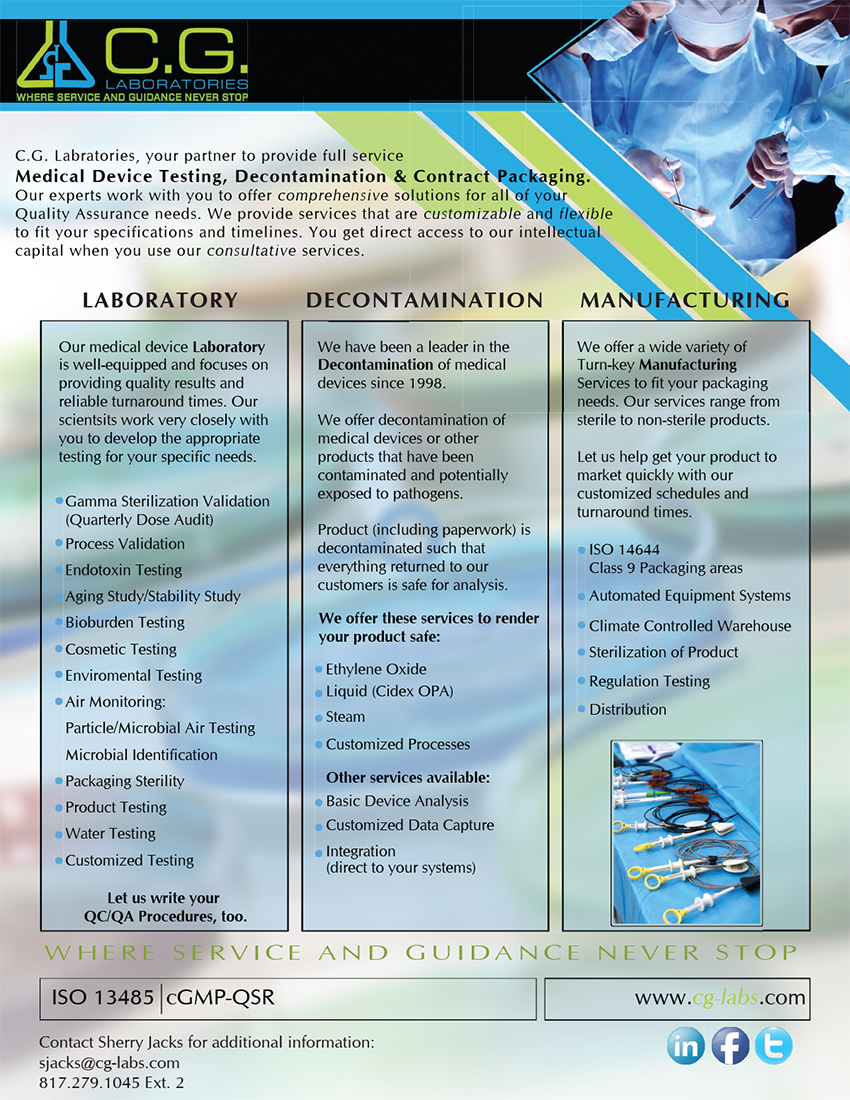Introduction
Most people in the medical device industry are aware of the change that is occurring with DuPont’s Tyvek material. Essentially, DuPont is not changing the product, but only changing the manner in which it is manufactured. DuPont is switching to the latest flash-spinning technology in 2015.
It is my belief that the majority of the CG Laboratories customers do not want to read all the detail of the testing and learn all of what DuPont has done. They just want to know the bottom line. Therefore this is designed to draw the “bottom line” for CGL customers. For those of you that just want to skip from here and read the summary- go for it!
A direct link to lots of information and data is at www.areyouready.tyvek.com.
Facts
DuPont has been in contact with the US Food and Drug Administration and has developed a plan to demonstrate Functional Equivalence of Tyvek that utilizes the new manufacturing process. The FDA agrees to this plan and will actually be signing off sometime hopefully in September 2015.
The DuPont plan is to perform extensive testing to demonstrate that there is enough data to demonstrate functional equivalence so that companies that use Tyvek do not have to re-validate. Isn’t that some good news? However, throughout the documentation distributed by DuPont they emphasize the need for each company to determine what steps are necessary given that each situation is different.
*DuPont Submission to U.S. FDA Fast Approaching the Finish Line “Are You Ready?” May 21, 2015
Testing Summary:
Below I will attempt to provide enough information to help shed some light on what testing has been done and why it was done and the interpretation of those results.
Breathability and microbial penetration- This is probably the most impactful important aspect that DuPont could do to help the medical device community. All users of Tyvek would like to know that the Tyvek will continue to allow gases (ethylene oxide and humidity) to flow through Tyvek while stopping microbes. DuPont has performed the below testing to demonstrate that it behaves in the same way as the old Tyvek.
- Curley porosity- demonstrates the porosity of the material and the new Tyvek material porosity is identical to the porosity of the Current Tyvek.
- MVTR- testing is to ensure humidity passes through the material the same as the old Tyvek.
- EO residual testing- testing to determine if harmful EO residuals are on products after EO sterilization.
- D-Value testing- lethality testing with biological indicators to demonstrate that the new Tyvek behaves in the same manner to allow ethylene oxide sterilization to kill microbes.
- Microbial barrier testing- demonstrates that Tyvek will not allow microbes to pass through Tyvek and remain a sterile barrier.
All testing performed above demonstrated that the new Tyvek was Functional Equivalent to the old Tyvek.
Withstand sterilization– DuPont wanted to demonstrate that the new Tyvek material would function in the same tried-and-true way that Tyvek has behaved in the past by withstanding all different types of sterilization methods. Both forms of Tyvek, 1073B and 1059B in coated and uncoated forms were exposed to the following sterilization methods, EO, Gamma radiation, and E-Beam. The following tests were performed on Current and new Tyvek materials before and after sterilization;
- Seal Strength (ASTM F88)
- Microbial Barrier (ASTM F2638)
- Package Integrity (ASTM F1929)
- Visual Inspection (ASTM F1886M).
All samples of all testing using the different sterilization methods passed all acceptance criteria and demonstrated that the new Tyvek was Functionally Equivalent to withstand and be compatible with Gamma, EO, and E-Beam sterilization.
*All information from: DuPont Tyvek® Medical Packaging Transition Project, Pre-Sterilization and Post-Sterilization Industry Summary Report (Corrected), April 2015. http://www.dupont.com/content/dam/dupont/products-and-services/packaging-materials-and-solutions/medical-and-pharmaceutical-packaging-materials/documents/Industry_Summary_Report_Pre_Post_Sterilization.pdf
Shelf-life- DuPont set out to establish that Tyvek behaves in the same manner for several years using accelerated and real-time aging conditions. The new Tyvek material was aged in accelerated conditions and a multitude of testing performed to demonstrate equivalence. DuPont aged Tyvek in accelerated conditions for 1, 3, and 5 years (as of 8/20/15) using the different forms of Tyvek (1073B and 1059B) in coated and uncoated forms. DuPont used different forms of Tyvek packaging as well in this study:
- Pouches/bags
- Form-fill-Seal
- Lids/Rigid Trays
The Current Tyvek and New Tyvek was tested using the following methods and results.
| Test | Results |
| Seal Strength (ASTM F88) | Functional Equivalence |
| Microbial Barrier (ASTM F2638) | Non-Inferiority |
| Package Integrity (ASTM F1929) | No Dye Penetration |
After the testing was performed, DuPont had this to say for 1, 3, and 5 years accelerated aging summary. The package results “indicate Functional Equivalence between current Tyvek styles 1073B and 1059B and Transition Protocol material styles 1073B and 1059B.”
All information taken from the following:
DuPont Tyvek® Medical Packaging Transition Project, 1-Year Accelerated Aging Industry Summary Report (Correct), April 2015.
DuPont Tyvek® Medical Packaging Transition Project, 3-Year Accelerated Aging Industry Summary Report, June 2015.
DuPont Tyvek® Medical Packaging Transition Project, 5-Year Accelerated Aging Industry Summary Report, July 2015.
Seal strength– Seal strength has been demonstrated to be functional Equivalent based upon the Pre-Sterilization and Post-Sterilization testing. As mentioned previously Seal Strength demonstrated Functional Equivalence and Packaging integrity testing demonstrated no failures. *This is good news and gives confidence, but one must wonder if the Tyvek will behave identically on different equipment.
Biocompatibility, Pharmacopeia, and Bioburden – DuPont has performed industry-standard testing to demonstrate that the new Tyvek material passes all aspects. The list below demonstrates the testing performed and the results obtained.
| Cytotoxicity (ISO 10993-5) | PASS |
| Endotoxins | PASS |
| Skin irritation and sensitization (ISO 10993-10) | PASS |
| Bioburden (ISO 11737-1) | Similar performance to current Tyvek |
| Extractables and leachables(ISO 10993-18; Infrared spectroscopy; ICP-MS; GC-MS; UPLC-MS) | -No major bands of interested (infrared spectroscopy)-Met all requirements |
All testing met DuPont expectations and passed all requirements.
* Results taken from Biocompatibility, Food Contract, and Pharmacopeia Testing DuPont Tyvek, March 12, 2015
Summary
To make a short and sweet summary, DuPont has taken great lengths to demonstrate that the Tyvek material manufacturing using the new technology is the same as the current Tyvek material. They have performed very extensive testing of the critical aspects of a sterile barrier packaging material. However, the one area that we wonder is if the new Tyvek material will behave the same on different equipment, because let’s be honest, DuPont can’t perform all this testing using your equipment. Most likely, it will but we wouldn’t want our customers to find out that their seal is not as strong with the new Tyvek as with the old Tyvek.
So, here is what we recommend.
- Order some new Tyvek material from your Supplier. It is readily available.
- Perform seal strength, package integrity testing, and visual testing using the Current Tyvek and the new Tyvek.
- Run some statistical analysis on these data to demonstrate that the new Tyvek behaves the same.
- Write a brief summary report. Show FDA and ISO that you have considered the issues with the new Tyvek and that you are not in the dark. This could be important during an audit or inspection.
- The link to this report is a good report that summarizes the DuPont findings and might be helpful to include in your summary report. http://www.dupont.com/content/dam/dupont/products-and-services/packaging-materials-and-solutions/medical-and-pharmaceutical-packaging-materials/documents/MPTP_June_2015_Customer_Letter.pdf
However, please know that each situation is different and this might not be the best course of action for you, but we believe that it will suffice for most of our customers. Other things that you can perform and should consider:
- Risk Analysis on your product and process
- A more detailed summary report
References
- DuPont Tyvek® Medical Packaging Transition Project, Pre-Sterilization and Post-Sterilization Industry Summary Report (Corrected), April 2015.
- DuPont Tyvek® Medical Packaging Transition Project, 1-Year Accelerated Aging Industry Summary Report (Correct), April 2015.
- DuPont Tyvek® Medical Packaging Transition Project, 3-Year Accelerated Aging Industry Summary Report, June 2015.
- DuPont Tyvek® Medical Packaging Transition Project, 5-Year Accelerated Aging Industry Summary Report, July 2015.
- Results taken from Biocompatibility, Food Contract, and Pharmacopeia Testing DuPont Tyvek, March 12, 2015
- *DuPont Submission to U.S. FDA Fast Approaching the Finish Line “Are You Ready?” May 21, 2015
All content provided on this blog is for informational purposes only. The author and/or CG Laboratories, Inc. make no representations as to the accuracy or completeness of any information on this site or found by following any link on this site.
The author and/or CG Laboratories, Inc. will not be liable for any errors or omissions in this information nor for any losses, injuries, or damages from the display or use of this information.
The terms and conditions of this blog are subject to change at anytime with or without notice.


